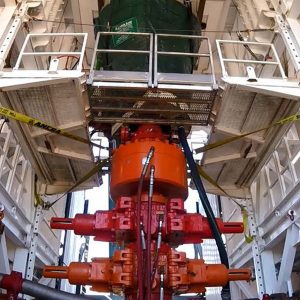Objective #
The objective was to verify and measure the amount of drilling fluids released during tripping operations vs the amount of fluids that can be collected and recovered, during an actual drilling operation.
Summary #
A system was installed on a drilling rig by Katch Kan field technicians and the data was collected during four tripping events by a third-party engineering firm. The following data was tracked:
1. The volume of drilling fluid released from the drill string
2. The volume of drilling fluid released on the rig floor and substructure
Verification Process #



A backdrop target zone (BTZ) consisting of light coloured impermeable fabric was installed below the rig floor and BOP structure to collect any drilling fluid released on the rig floor and substructure. A visual evaluation of the percentage of BTZ covered by splatter was made using reclamation assessment visual estimation charts.
| Table | Calculated Volume Released | |||
| Trip Event | Drilling Fluid Released from Drill String (L) | Total Drilling Fluid Collected (L) | Total Drilling Fluid Released into the Environment (L) | Drilling Fluid Released to the Environment (%) |
| 1 | 3,530.00 | 3,528.23 | 1.77 | 0.05 |
| 2 | 3,040.00 | 3,037.56 | 2.44 | 0.08 |
| 3 | 3,420.00 | 3,414.90 | 5.1 | 0.19 |
| 4 | 3,430.00 | 3,428.56 | 1.44 | 0.04 |
| Totals | 13,420.00 L | 13,409.25 L | 10.75 L | 0.08 % |

Results #
The Katch Kan System Collected 99.9% of the drilling fluids during 4 tripping operations and it was verified by the Environmental Technology Verification Program.

Conclusion #
The results of this study prove:
- The Fluid Containment System is reliable to recover fluids and avoid contamination in 99.9%
- Big savings on drilling fluids and cleanup costs during and after production
- The Fluid Containment System is a proactive and sustainable solution for the upstream
- Significant Environmental Protection
- Significant improvement in Worker Safety
Contact us for more details about this case study




